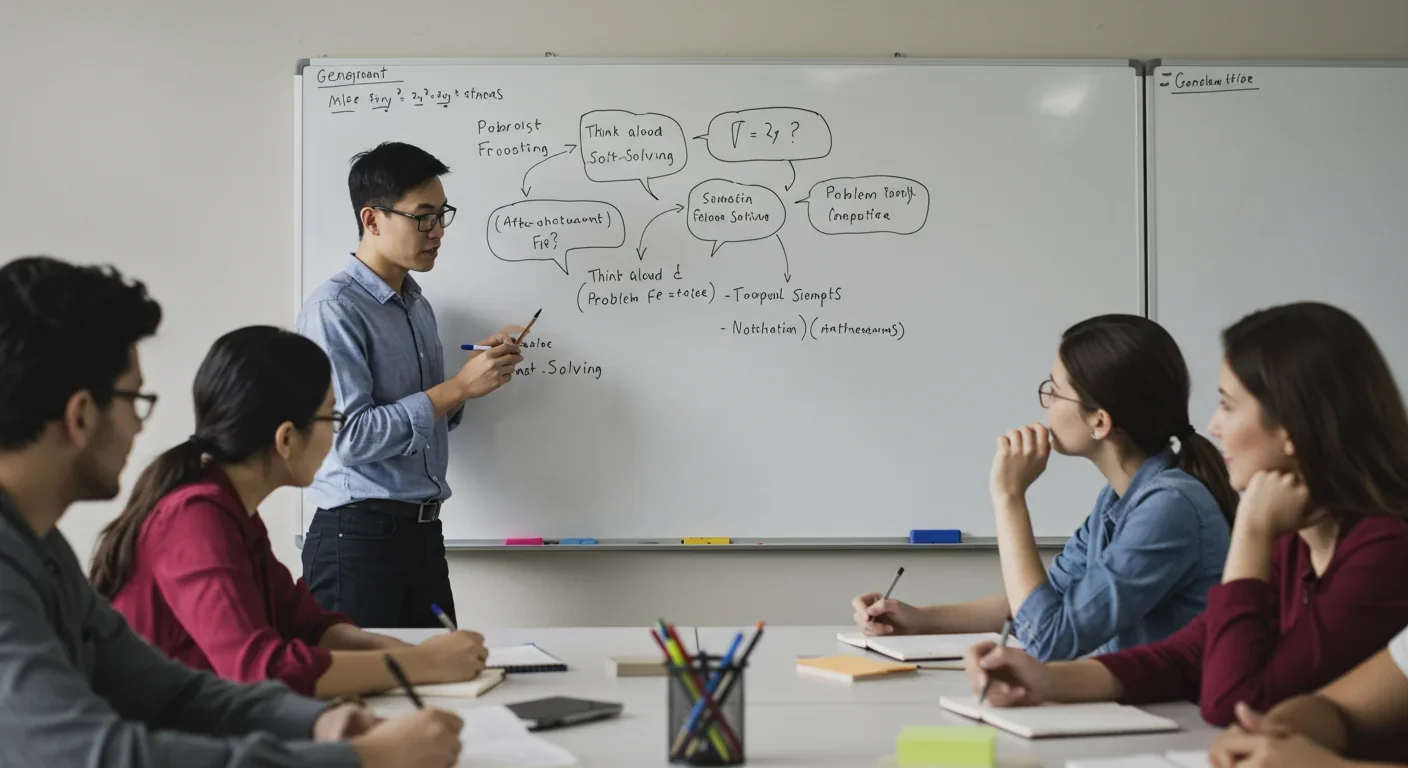Transactive Memory: The Shared Mind System in Relationships

TL;DR: Metacognition—thinking about your thinking—is the hidden superpower that separates exceptional learners from average ones. Research shows students trained in metacognitive strategies gain 8 months of additional progress per year by learning to plan, monitor, and evaluate their learning. From John Flavell's 1970s breakthrough to modern neuroscience revealing brain changes, the evidence is clear: metacognition isn't innate talent but a teachable skill involving self-questioning, retrieval practice, and reflection routines that transform how we learn across all subjects and contexts.

You've spent hours studying, your notes are perfect, and you feel ready for the exam. Then you sit down, read the first question, and... nothing. That confidence you had? It was an illusion. Welcome to one of learning's cruelest tricks—and the reason why "thinking about your thinking" might be the most powerful skill you never knew you needed.
Scientists call it metacognition, and it's the difference between students who merely work hard and those who work smart. It's why some people can learn a new language in months while others struggle for years. It's the secret ingredient behind every breakthrough, every "aha!" moment, and every time someone goes from average to exceptional. And here's the kicker: most schools never teach it.
In the 1970s, developmental psychologist John Flavell made a discovery that would revolutionize our understanding of learning. While studying how children think, he noticed something peculiar: some kids didn't just solve problems—they watched themselves solve problems. They narrated their thought process, questioned their assumptions, and adjusted their strategies in real-time. Flavell called this "thinking about thinking," and it turned out to be the cognitive equivalent of a superpower.
The research was stunning. Students trained in metacognitive strategies gained an average of eight additional months of academic progress in a single year—more than most educational interventions combined. The Education Endowment Foundation, after analyzing hundreds of studies, found that metacognition consistently outperformed other teaching methods with an effect size of 0.69. To put that in perspective, that's like taking a C student and watching them become an A student, not through more hours of study, but through smarter thinking.
But here's what makes metacognition truly revolutionary: it doesn't just help you learn better—it helps you become aware of how you learn. Brain imaging studies at Georgetown University revealed something astonishing: when students developed metacognitive skills, their brain activity patterns changed in ways that predicted learning success better than traditional test scores. The posterior parietal cortex—the brain region associated with spatial and verbal reasoning—showed increased activation, suggesting that metacognition literally rewires how we think.
The concept of examining one's own thoughts isn't new. Socrates built his entire teaching method around it with his famous dialectic questioning: "How do you know what you know?" The Socratic method forced students to confront the gaps in their understanding, to think about their thinking process. But it took until 1976 for science to catch up with philosophy.
John Flavell's foundational research focused on children's "theory of mind"—their ability to understand that others have different thoughts and beliefs. His famous appearance-reality experiments showed that while three-year-olds failed to distinguish between how things appear and how they actually are, five-year-olds succeeded. This developmental milestone marked the emergence of mental representation—the ability to hold reality and one's perception of reality as two separate entities in the mind.
This was the seed of metacognition. By the 1990s, researchers like Barry Zimmerman had expanded the concept into "self-regulated learning," showing that students who planned, monitored, and evaluated their learning consistently outperformed their peers. The evidence mounted: metacognition wasn't just an academic curiosity—it was a fundamental pillar of human intelligence.
Fast forward to today, and neuroscience is revealing the biological basis of these skills. fMRI studies show that metacognitive monitoring activates the prefrontal cortex—the brain's executive control center. When you pause to ask yourself, "Do I really understand this, or does it just feel familiar?" you're engaging neural circuits that distinguish experts from novices.
Metacognition operates through three interconnected systems that transform how you process information:
Metacognitive Knowledge is your understanding of how learning works—both in general and for you specifically. It's knowing that you're better at remembering visuals than text, or that you need absolute silence to concentrate on math but background music helps with writing. Research shows this self-awareness is what separates high achievers from the rest. In one landmark study, students with low metacognitive knowledge couldn't distinguish their actual performance from their perceived performance, ranking themselves in the 62nd percentile when they actually scored in the 12th—a phenomenon now famous as the Dunning-Kruger Effect.
Metacognitive Regulation is where the magic happens. This is the active process of planning your approach before tackling a task, monitoring your understanding during learning, and evaluating your results afterward. Think of it as having an internal coach who constantly asks: "What's my strategy here? Is this working? What should I adjust?" Studies with middle school math students showed that those trained in metacognitive regulation—using self-questioning checklists and error analysis—dramatically outperformed peers who received standard instruction.
Metacognitive Experiences are those gut-level feelings during learning: the "click" when something makes sense, the fog of confusion, the false confidence that comes from rereading the same material. Learning to interpret these feelings accurately is crucial. Cognitive scientist Megan Sumeracki explains the "fluency trap": "The first time you read something, it's hard. The second time, it feels easier, so you think you know it better. But that ease is an illusion—you're just recognizing the words, not actually retrieving the knowledge."
What makes metacognition so powerful is how these three pillars work together. Your knowledge informs your regulation strategies, which create experiences that update your knowledge—a continuous feedback loop that compounds over time. It's like compound interest for your brain.

The implications extend far beyond individual students. Schools implementing whole-school metacognitive programs are seeing transformative results. When educators at the University of Waterloo introduced "exam wrappers"—simple reflection prompts before and after assessments—students began to recognize their own learning patterns. The three questions were deceptively simple: "How did you prepare? What kinds of errors did you make? How will you prepare differently next time?" Yet this structured reflection created measurable improvements in subsequent performance.
John Hattie's synthesis of over 800 meta-analyses identified metacognition as one of the most powerful educational interventions, surpassing class size reduction, homework, and even one-on-one tutoring. The effect size of 0.69 translates to roughly 1.5 years of additional learning progress over a typical academic year. Yet despite this evidence, most curricula still focus almost exclusively on content delivery rather than teaching students how to learn.
The workplace is taking notice. Corporate training programs increasingly incorporate metacognitive strategies, recognizing that employees who can self-regulate, identify knowledge gaps, and adapt their learning strategies are invaluable in rapidly changing industries. A Forbes survey found that 80% of senior executives believe employee growth mindsets—closely linked to metacognition—contribute directly to revenue growth, with 64% reporting higher productivity.
Technology is also entering the equation. Adaptive learning systems like intelligent tutoring software operationalize metacognitive monitoring by providing personalized feedback in real-time. A 2001 study by Kapa demonstrated that metacognitive prompts in computerized problem-solving environments increased correct responses by 15% among secondary students. AI-driven platforms are now being developed to tailor interventions to individual metacognitive profiles, though implementation challenges like digital inequity remain significant barriers.
The beauty of metacognition is its universality. Unlike domain-specific skills, metacognitive strategies transfer across subjects and contexts. A student who learns to self-question in math class carries that skill to history, science, and eventually their career. Research shows metacognition is domain-general, compensating for IQ differences and prior knowledge gaps.
For struggling learners, the impact is especially profound. Students with specific learning difficulties or mathematical disabilities show marked improvement when taught metacognitive strategies alongside content. When teachers pair cognitive strategies (like breaking problems into steps) with metacognitive strategies (like self-monitoring checklists based on individual error patterns), students gain both competence and confidence. They move from dependency to autonomy.
The leveling effect is remarkable. Studies consistently show that students from disadvantaged backgrounds benefit significantly from metacognitive training, as it empowers them to take control of their learning regardless of external resources. Metacognition becomes an equalizer, providing tools that don't require expensive technology or extensive parental support—just deliberate practice and structured guidance.
Consider active recall paired with spaced repetition—a combination that leverages metacognitive monitoring. When you test yourself and struggle to retrieve information, that difficulty creates a more accurate picture of what you actually know versus what merely feels familiar. The struggle itself strengthens memory traces. Platforms like Brainscape have built entire learning systems around this principle, combining retrieval practice with metacognitive reflection and achieving measurable gains in long-term retention.
But metacognition isn't a panacea, and its implementation faces significant hurdles. The most fundamental challenge? Many teachers themselves lack deep understanding of metacognitive theory. Without grasping the "why" behind metacognitive strategies, educators struggle to model them effectively. Professional development is essential, yet often insufficient or poorly designed.
There's also the abstraction problem. Metacognition is, by nature, invisible. Asking students to "think about their thinking" can feel like asking them to describe the color of air. Some learners find it genuinely difficult to step back and observe their own cognitive processes, especially younger students whose prefrontal cortex is still developing. The curriculum crunch doesn't help—packed schedules leave little room for the reflection and discussion that metacognitive development requires.
Then there's the accuracy paradox highlighted by the Dunning-Kruger Effect: those who most need metacognitive skills are precisely the ones least able to recognize their absence. Bottom-quartile students consistently overestimate their performance because they lack the discriminatory ability to judge quality. This creates a vicious cycle: incompetence prevents recognition of incompetence, which prevents seeking improvement.
Overconfidence isn't the only bias at play. Social desirability distorts self-assessment—students may inflate their self-evaluations hoping to influence teachers' perceptions. Gender differences emerge too, with male students systematically rating their performance higher than female students on identical work. These biases muddy the waters, making accurate metacognitive monitoring more difficult.
Technology introduces its own complications. While digital tools can support metacognition, they can also enable cognitive outsourcing. When students rely on AI to organize their thoughts or algorithms to space their practice, are they developing metacognitive skills or delegating them? The jury is still out.
Metacognition isn't culturally neutral. Different societies emphasize different aspects of self-awareness and self-regulation. Eastern educational systems, particularly in countries like Japan and South Korea, have long emphasized reflective practice and self-evaluation—core components of metacognition. The Japanese concept of "kaizen" (continuous improvement) embeds metacognitive reflection into daily life.
Western approaches tend to focus more on individual agency and strategy selection, while collectivist cultures may emphasize metacognition in group contexts—monitoring not just one's own understanding but the group's collective comprehension. Research on collaborative metacognition shows that structured group discussions can enhance individual metacognitive skills, but only when carefully designed to ensure equitable participation and explicit articulation of thinking.
Internationally, organizations like the Education Endowment Foundation in the UK and similar bodies worldwide are translating metacognitive resources into multiple languages and making them freely available. This democratization of knowledge reduces barriers, allowing educators in diverse linguistic and economic contexts to implement evidence-based practices. However, translation alone isn't enough—cultural adaptation matters. What counts as effective self-questioning in one context may feel uncomfortable or inappropriate in another.
The PISA 2018 assessment, which surveyed over 600,000 students across 79 countries, analyzed metacognitive reading strategies globally. The findings were revealing: while specific strategies varied in importance across contexts, the directional relationship remained consistent—metacognitive strategy use positively predicted achievement everywhere. Underlining key passages, checking summary accuracy, and verifying website credibility emerged as universal predictors of reading skill, suggesting a cross-cultural core to metacognitive effectiveness.

So how do you actually develop this "hidden superpower"? The research points to several high-impact strategies:
Self-questioning tops the list with an effect size of 0.64 in Hattie's analysis. But not all questions are equal. Vague prompts like "How did you do?" produce vague results. Structured questions work better: "What part was easiest and why? Where did you struggle? What specific strategy could help next time?" Teachers can provide question stems initially, gradually releasing responsibility as students internalize the practice.
Retrieval practice forces honest self-assessment. Instead of rereading notes (which creates false confidence), close the book and attempt to recall. The difficulty of retrieval provides accurate feedback about what you actually know. Studies show this "desirable difficulty" not only strengthens memory but calibrates metacognitive monitoring—you become better at judging your own knowledge.
Planning and reflection routines bookend learning sessions. Before starting, ask: "What's my goal? What strategy will I use? What resources do I need?" After finishing: "Did my strategy work? What would I do differently? What did I learn about how I learn?" The University of Waterloo's exam wrapper protocol institutionalizes this cycle, prompting students to predict performance before assessments and compare predictions to reality afterward.
Think-aloud protocols make the invisible visible. When teachers model their problem-solving process by narrating their thoughts—"I'm noticing a pattern here, so I'm going to test whether it holds... yes, that confirms my hypothesis"—students see what expert thinking actually looks like. For learners with disabilities, this explicit modeling is especially powerful, providing a concrete template for self-instruction.
Error analysis transforms mistakes from failures into learning opportunities. Rather than just correcting wrong answers, students analyze the type of error: Was it a careless mistake? A conceptual misunderstanding? A gap in prerequisite knowledge? This diagnostic approach, when paired with individualized self-monitoring checklists, helps students with mathematical disabilities identify and address their specific error patterns.
Spaced self-testing combines temporal spacing with active retrieval. Start each lesson with quick-fire questions from previous material, spacing them out over days and weeks. This distributed practice not only enhances retention but provides repeated opportunities to gauge understanding. One teacher's simple implementation—three review questions before each new lesson, gradually phasing out old content and introducing new—dramatically improved summative assessment scores.
The key is consistency. Metacognitive skills develop through repeated practice, not one-off activities. Making self-assessment part of the daily routine—even brief traffic-light reflections (red: don't get it, yellow: kind of get it, green: got it!)—builds the habit of self-monitoring. Over time, it becomes automatic, an inner dialogue that runs continuously in the background.
Here's what the research makes crystal clear: metacognition isn't an innate talent that some possess and others don't. It's a skill, and like any skill, it can be developed through deliberate practice. The students who seem "naturally" good at learning? They've simply internalized metacognitive strategies, often unconsciously. The good news is you can make that unconscious process conscious and accelerate your development.
Start small. Pick one strategy—maybe self-questioning—and commit to it for a month. After each study session, ask yourself three questions: What did I learn? What's still unclear? How will I address those gaps? Track your answers in a simple learning journal. You'll start noticing patterns in your learning, identifying what works and what doesn't.
Next, introduce retrieval practice. Instead of rereading your notes, test yourself. Use flashcards, practice problems, or simply try to write out everything you remember without looking. Embrace the struggle—that difficulty is feedback, telling you exactly where to focus your efforts. Platforms like Brainscape or Anki can help structure this practice, but a blank sheet of paper works just as well.
As you build these habits, start planning learning sessions explicitly. Before diving into material, set a specific goal and choose a strategy. "I'm going to master these five concepts by creating a concept map and then explaining them aloud" is far more effective than "I'm going to study for two hours." The specificity forces metacognitive engagement from the start.
For teachers and parents, the opportunity is even greater. Model metacognitive thinking aloud. When working through problems together, narrate your thought process: "Hmm, I'm not sure about this, so I'm going to check my understanding by explaining it in my own words." Create a classroom culture where mistakes are celebrated as learning opportunities, where self-assessment is routine, and where reflection is valued as much as performance.
Implement simple structures like exam wrappers or pre-lesson prediction exercises. Provide question stems to scaffold self-questioning until students can generate their own. Most importantly, teach students the "why" behind these strategies. When learners understand that retrieval practice strengthens memory or that planning improves efficiency, they're more likely to adopt these practices independently.
The future of education increasingly recognizes what researchers have known for decades: teaching content without teaching how to learn is like giving someone ingredients without a recipe. Schools that embrace metacognition are preparing students not just for tests, but for a lifetime of adaptive learning in a rapidly changing world.
We're standing at a threshold. Neuroscience is revealing the brain mechanisms underlying metacognition. Technology is creating personalized tools to support it. And educational research continues to refine our understanding of how to teach it effectively. The question isn't whether metacognition matters—the evidence is overwhelming. The question is whether we'll have the wisdom to make it central to how we educate.
Your brain's hidden superpower isn't actually hidden—it's just waiting to be unlocked. Metacognition is the key, and every moment is an opportunity to practice. The next time you sit down to learn something, pause. Think about your thinking. Plan your approach. Monitor your understanding. Reflect on your results. Do this consistently, and you won't just become a better student—you'll become a better thinker, a better problem-solver, a better learner. And in a world where the ability to learn may be the most valuable skill of all, that changes everything.

Over 80% of nearby white dwarfs show chemical fingerprints of destroyed planets in their atmospheres—cosmic crime scenes where astronomers perform planetary autopsies using spectroscopy. JWST recently discovered 12 debris disks with unprecedented diversity, from glassy silica dust to hidden planetary graveyards invisible to previous surveys. These stellar remnants offer the only direct measurement of exoplanet interiors, revealing Earth-like rocky worlds, Mercury-like metal-rich cores, and ev...

Hidden mold in homes releases invisible mycotoxins—toxic chemicals that persist long after mold removal, triggering chronic fatigue, brain fog, immune dysfunction, and neurological damage. Up to 50% of buildings harbor mold, yet most mycotoxin exposure goes undetected. Cutting-edge airborne testing, professional remediation, and medical detox protocols can reveal and reverse this silent epidemic, empowering individuals to reclaim their health.

Data centers consumed 415 terawatt-hours of electricity in 2024 and will nearly double that by 2030, driven by AI's insatiable energy appetite. Despite tech giants' renewable pledges, actual emissions are up to 662% higher than reported due to accounting loopholes. A digital pollution tax—similar to Europe's carbon border tariff—could finally force the industry to invest in efficiency technologies like liquid cooling, waste heat recovery, and time-matched renewable power, transforming volunta...

Transactive memory is the invisible system that makes couples, teams, and families smarter together than apart. Psychologist Daniel Wegner discovered in 1985 that our brains delegate knowledge to trusted partners, creating shared memory networks that reduce cognitive load by up to 40%. But these systems are fragile—breaking down when members leave, technology overwhelms, or communication fails. As AI and remote work reshape collaboration, understanding how to intentionally build and maintain ...

Mass coral spawning synchronization is one of nature's most precisely timed events, but climate change threatens to disrupt it. Scientists are responding with selective breeding, controlled laboratory spawning, and automated monitoring to preserve reef ecosystems.

Your smartphone isn't just a tool—it's part of your mind. The extended mind thesis argues that cognition extends beyond your skull into devices, AI assistants, and wearables that store, process, and predict your thoughts. While 79% of Americans now depend on digital devices for memory, this isn't amnesia—it's cognitive evolution. The challenge is designing tools that enhance thinking without hijacking attention or eroding autonomy. From brain-computer interfaces to AI tutors, the future of co...

Transformers revolutionized AI by replacing sequential processing with parallel attention mechanisms. This breakthrough enabled models like GPT and BERT to understand context more deeply while training faster, fundamentally reshaping every domain from language to vision to multimodal AI.